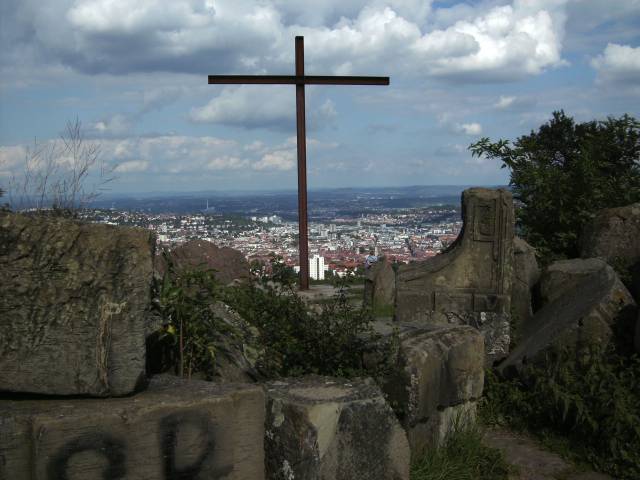"Den Opfern zum Gedächtnis den Lebenden zur Mahnung"
[English text follows]
So steht es auf der Gedenktafel des Monte Scherbelino, wie
Stuttgarts wohl bekanntester Berg genannt wird. Von dem 10 Meter
hohen fast 2 ½ Tonnen schweren Kreuz auf dem Berg hat man eine
grandiose Aussicht auf Stuttgart. Wenn man von dort runterschaut,
kann man sich nicht mehr vorstellen, wie Stuttgart nach dem 2.
Weltkrieg aussah. Deswegen dient dieser Trümmerberg heute als
eindrucksvolles Mahnmal. Und an einem einerseits so schönen
Aussichtspunkt und anderseits doch sehr denkwürdigen Ort, darf
natürlich auch ein Dösle nicht fehlen, das interessierte Geocacher
hier her lenkt. Achtung: Bei Nässe oder im Winter kann das Terrain
schnell zu T4 werden

(Bildquelle: trekearth.com)
Insgesamt 53 Luftangriffe erfolgten zwischen 1940 und 1945 auf
Stuttgart. Der schwerste Angriff erfolgte am 12. September 1944
durch die britische Royal Air Force auf die Stuttgarter Altstadt.
Dabei wurden 75 schwere Luftminen, 4.300 Sprengbomben und 180.000
Brandbomben abgeworfen. In den Kriegsjahren kamen in Stuttgart 4477
Menschen ums Leben, 8909 wurden schwer verletzt. 68 % aller
Wohngebäude und 75 % der industriellen Anlagen waren bei Kriegsende
zerstört und die Innenstadt war von etwa 5 Millionen Kubikmetern
Schutt bedeckt.

Stuttgarts Königstrasse 1945 (Quelle:StZ)
Am 10.4.1945 ließ Oberbürgermeister Strölin schließlich den
französischen Truppen erklären, man sei jetzt zu einer Kapitulation
Stuttgarts bereit. Am 22.4.1945 übergab er dann schließlich die
Stadt an die Franzosen. Fanatische Nazi-Anhänger sprengten dann in
letzter Minute noch weitgehend alle Neckarbrücken. Danach wurde
Strölin von den Amerikanern gefangengenommen. Zur Zeit der
bedingungslosen Kapitulation lebten in der Ruinenstadt nur noch 266
067 Menschen.
Für den Wiederaufbau erschied man sich einen Großteil der
Trümmer und Mauerstücke der eingefallenen Hausfassaden auf dem am
Stadtrand gelegenen Birkenkopf zu deponieren. Zum Transport musste
wegen fehlender Lastwagen nicht nur eine mit Dampf betriebene
Trümmerbahn benutzt werden, sondern auch die Straßenbahn, die schon
wenige Tage nach der Kapitulation teilweise wieder ihren Betrieb
aufgenommen hatte. Im Oktober 1953 schließlich fuhr der letzte LKW
mit Schutt auf den Hügel, der dann mit 511Metern ü. NN um
stattliche 40Meter gegenüber vor dem Krieg gewachsen war.

Erwähnenswerte Fotos vom Monte Scherbelino
Panoramsicht
von Hans-Dieter Teschner
Luftbild vom Monte Scherbelino
Wer Quick Time installiert hat kann sich auch die 360° Panoramen
anschauen:
360°
Panorama 1
360°
Panorama 2
"To the victims for memory to the living as reminder"
This is what you can read on the memorial tablet of the Monte
Scherbelino, the nickname of Stuttgart's most famous hill. There is
a terrific scenic view from the monstrous cross on top of the hill
which has a height of 10 meters and a weight of 2.5 tons. Just
looking from there on Stuttgart nothing will remind you on how the
city looked like right after second world war. For this reason this
rubble hill in the back serves today as an impressive memorial. A
geocache at such location is imperative, at least to guide the
interested to a beautiful and at the same time very memorable
place.
A total of 53 air attacks had been carried out on Stuttgart in
the yeas between 1940 and 1945. The most severe attack was carried
out on September 12th 1944 by the British Royal Air Force on the
center of Stuttgart. During this attack 75 heavy block busters,
4.300 explosive bombs and 180.000 fire bombs were dropped. In the
war years 4477 inhabitants were killed, 8909 were severly injured.
At the end of the war 68% of the residential buildings and 75% of
the industrial plants had been destroyed and the city center was
buried under 5 million cubicmeters of debris and rubble.
April 4th, 1945 the mayor of Stuttgart informed the French
troops that Stuttgart is ready for capitulation. April 22nd, 1945
he finally handed over the city to the French. Fanatic Nazi
supporters still blew up all Neckar bridges last minute. After this
Strölin was captured by the Americans. At the time of the termless
capitulation only 266.067 residents remained living in the
town.
For reconstructing the town the responsibles decided to deposit
the majority of debris and rubble on the Birkenkopf, a hill at the
western city boundary. Due to missing trucks a steam driven rubble
train was used as well as the tramway which resumed operation only
a few days after capitulation. In October 1953 the last truck with
rubble climbed the hill, which grew in height by 40m compared to
before the war to 511 meters over see level.
Attention: When the weather is wet or during winter the terrain
may easily become T4.
Häppy Caching, Webdax